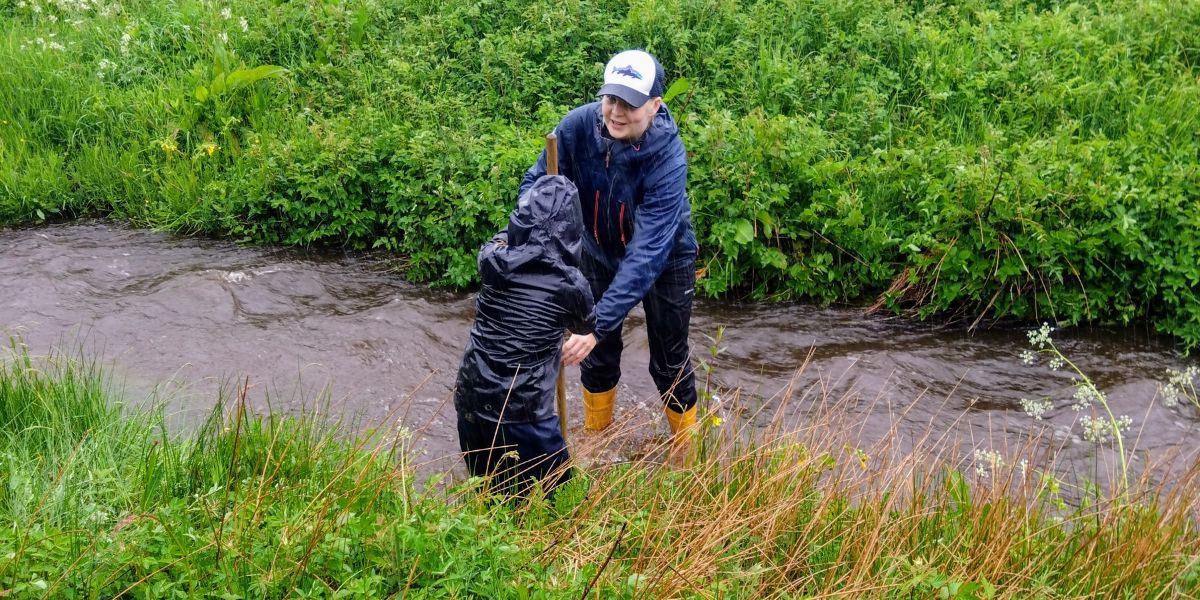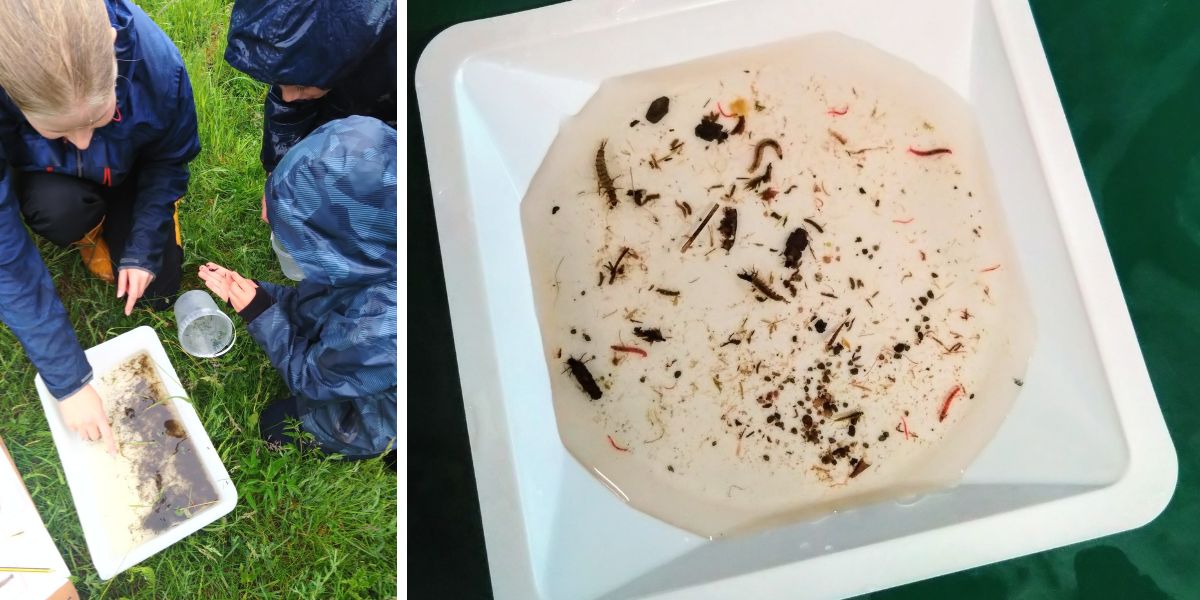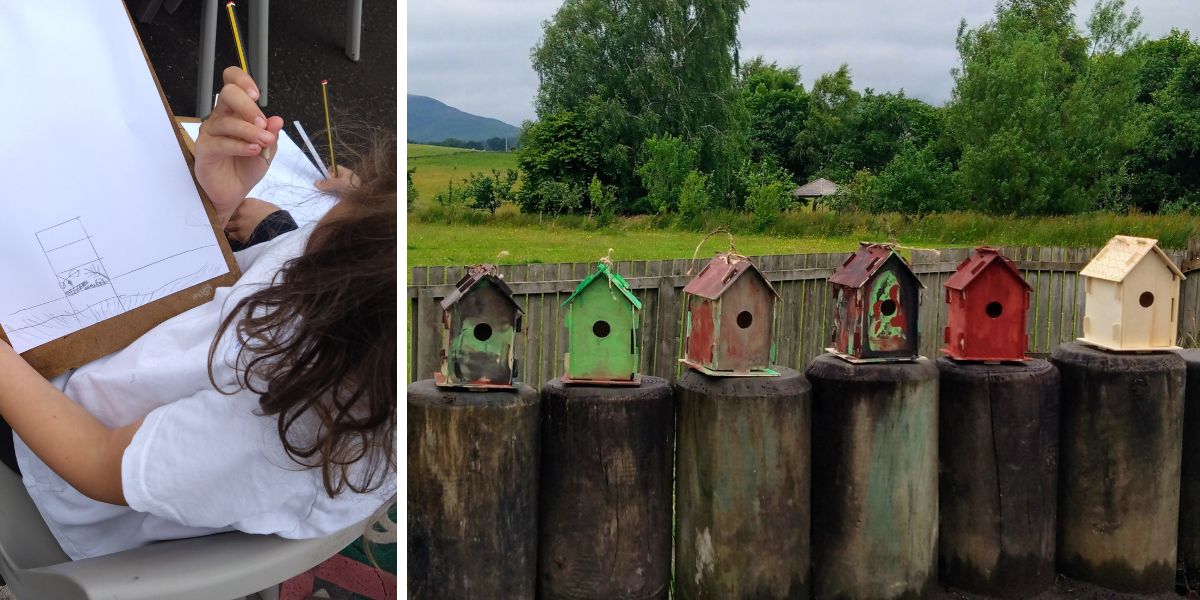
P2/P3 Learners in Scotland Bringing Nature-Inclusive Design to Life
When Drymen Primary School piloted Unit 3 of the Primary DEC programme, their P2/3 class swapped worksheets for wellies – surveying habitats, catching river creatures and building wildlife homes on their school grounds.
With support from ecologists at the University of Glasgow and sustainability experts from ECD Architects, these 6–8 year-olds learned that protecting nature starts right where you live and learn.

The school piloted Unit 3: Building with Nature over a nine-week period during the summer term of 2024/25. The project was delivered to a class of 22 P2 and P3 learners within the schools STEM topic, led by Gill Rae (Class Teacher), who said:
“Thank you so much for all the organising and resourcing you did to ensure an engaging and meaningful learning experience for the children.”
The school had two support visits during the project. The first was an ecology workshop for ‘Activity 2: School Wildlife Survey’ supported by University of Glasgow staff, led by Hannele Honkanen (Research Assistant).
The second session was a construction workshop for ‘Activity 6: Build Homes for Wildlife at School’ supported by ECD Architects and Lizzy Westmacott (Associate Director/Regional Head of Sustainability).
We caught up with Class Teacher, Gill, to hear how the project went and what her young learners took away from the experience.

Ecology Workshop: School Wildlife Survey
Despite a morning of torrential rain, Drymen Primary’s outdoor ecology session was a resounding success. Led by four ecology researchers from the University of Glasgow, the workshop formed part of the class’s School Wildlife Survey and saw every pupil enthusiastically diving into the activities – quite literally in some cases.
“The children were very enthusiastic and engaged,” said Class Teacher Gill Rae. “They all learned new things and had fun! I do have to warn you to be prepared for any sort of question…relevant or entirely random!”
From the children’s feedback below, it’s clear that they learned lots and enjoyed the morning:
“I liked the river activity best because I caught a fish/caught lots of moving creatures/bugs/water shrimp and Tim the Tadpole!”
“I thought the forest activity was the best because it was fun trying to spot different trees and flowers.”
“I learned about cuckoo flowers and forget-me-nots”
“I learned how to identify an elder tree.”
“If you can find certain species then that means the habitat is healthy. These are called indicator species.”
“I’d like to do fish ecology so that I could work in water.”
“I’d like to see lots of bugs so being a moth ecologist would be cool…and they are nocturnal.”

Construction Workshop: Build Homes for Wildlife at School
As the project neared its end, the class took on Activity 6: Build Homes for Wildlife at School – a hands-on construction workshop designed to bring together everything they’d learned about habitats, materials, and design.
Supported by sustainability experts from ECD Architects, the children worked in teams to design and build wildlife shelters including bird boxes and bug hotels, using natural and found materials from their school grounds.
For Class Teacher Gill Rae, the session stood out as a powerful example of how industry partnerships can elevate classroom learning: “The strength I see in this connection is the quality of the contacts, real-life experiences, and the quality of the end product.”
From gathering pinecones for their bug hotel to selecting the perfect spot for a bird box, the children were fully immersed in the process, taking ownership of their learning every step of the way.
“My favourite activity was making the bird boxes because I like being creative.”
“It was fun and tricky to find a spot for the bug hotel.”
“I learned that it’s important to take care of nature.”
“I learned that architects need to draw the plan of the building first.”
“Now I know how to design a house.”
“I would like to do a job like yours because you work in a team to figure it out.”
“My papa is an architect, so I know what to do and I am good at drawing.”
“I would like to do a job like yours because because I like building.”
About the school
Drymen Primary School is a non-denominational school located on the outskirts of Drymen village, Scotland, within the spectacular Loch Lomond and Trossachs National Park. From their school, they have outstanding views towards Conic Hill and Ben Lomond. Their grounds include a tarmac playground area, large field, woodland and a small burn and wild area. Geese, sheep and roe deer are common visitors to the school grounds. Drymen Primary School is committed to caring for its environment and maintains its Eco Schools Green Flag status. There are 22 children in the P2/3 class, ages ranging from 6-8 years old.
Book a DEC DISCOVERY CALL
Chat about learning, teaching and supporting DEC with one of our team
Are you from industry?
Visit the COYO website and learn how you can recruit exceptional DEC talent, improve your organisation’s diversity and surpass your ESG commitments!






